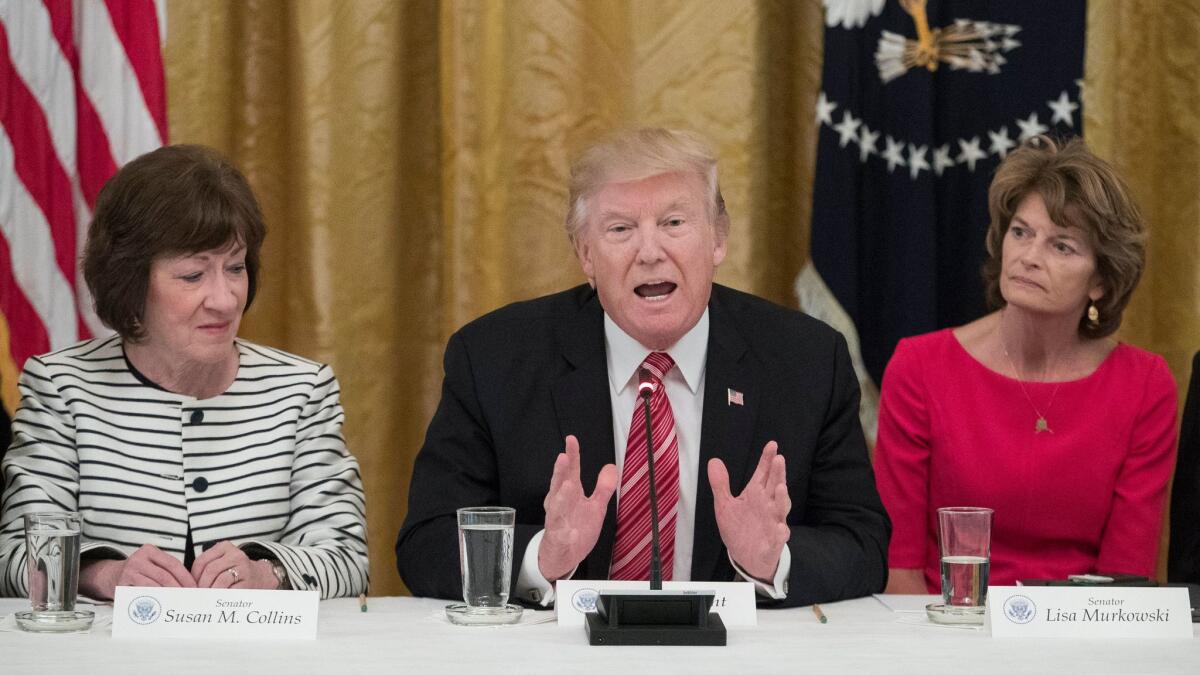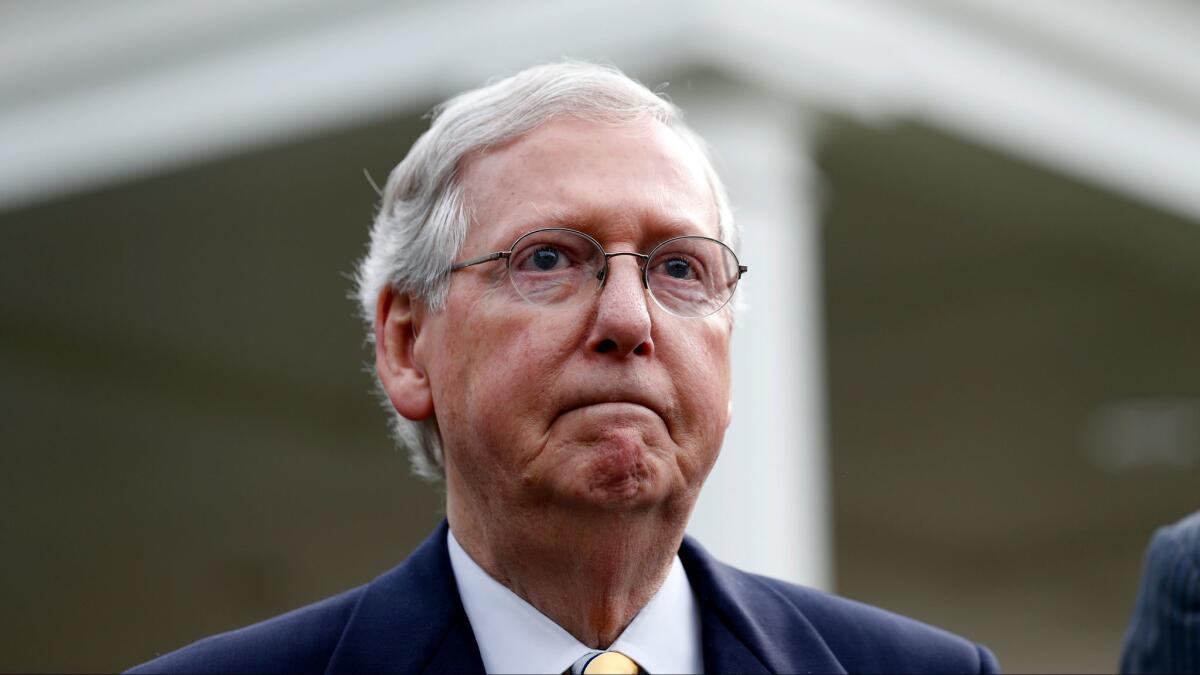Healthcare debate highlights the split that threatens to paralyze Republicans

Reporting from Washington â Six months after taking control of the White House and both houses of Congress, Republicans who campaigned for years on repealing Obamacare still canât agree on how to do it.
A chief reason that the struggle has been so hard is the growing importance in the party of populist blue-collar voters, whom Trump proved adept at courting, but Republicans risk alienating with their healthcare overhaul.
Itâs true, as Senate Majority Leader Mitch McConnell of Kentucky said Tuesday after temporarily shelving a vote on the healthcare bill, that âlegislation of this complexity almost always takes longer than anybody else would hope.â
Itâs also true, as Sen. Susan Collins (R-Maine) said, that President Trump is new to government, and âit has been a challenge to him to learn how to interact with Congress.â Trump, who touts himself as the âcloserâ in big deals, has proven ineffective in that role so far in the Senate, in part because of a failure to master not just the details of healthcare policy, but the broad outlines of how the bill would work.
But something more than the complexity of the subject and the dysfunction of the White House has stymied Republicans: The split over healthcare highlights a deep division that threatens to paralyze them as a governing party.
A side-by-side comparison of Obamacare and the GOPâs replacement plans Âť
Republicans âwere seemingly so disciplined in not lending any support to Democratsâ during the Obama years âthat we thought they were unified,â said Sarah Binder, a political science professor at George Washington University and expert on Congress.
âWeâve overestimated cohesion in the Republican Party,â she said, noting that Republicans have become more ideologically diverse over the last decade.
The splits within the party have McConnell and his allies scrambling to get the 50 votes they would need in the Senate to pass a bill, a goal he repeated on Wednesday. McConnell hopes to reach a deal by Friday, before senators leave for a weeklong July 4 recess, and then vote on it when they return. However, the longer the bill is exposed to public scrutiny and attack, not just from Democrats, but from doctors groups, hospital officials, insurers and some Republican governors, the harder the search for votes will become, he and his lieutenants fear.

If Republicans canât agree, McConnell said after senators met with Trump at the White House on Tuesday, âweâll have to sit down with Sen. [Charles. E.] Schumer,â the Democratic leader to negotiate a solution to at least tackle the most acute problems with the Obamacare markets.
But he made clear that bipartisan discussion was not his first choice. âMy suspicion is any negotiation with Democrats will include none of the reforms that we would like to make on the market side and the Medicaid side,â he added.
Republicansâ determination to pass the healthcare bill might seem puzzling in light of its deep unpopularity with voters. A poll for National Public Radio and PBS, conducted by the polling institute at Marist College in Poughkeepsie, N.Y., and released Wednesday, found, for example, that only one in five people approved of how the Republicans are handling healthcare. Even among those who identified themselves as Trump supporters, opinion was evenly divided on how the party is dealing with the issue, while Trump opponents were almost unanimous in their distaste for it.
Asked specifically about the Senate bill, just 17% of Americans â and only 35% of Republicans â said they approved of it.
Two other nationwide surveys, done by polling institutes at Suffolk University in Massachusetts and Quinnipiac University in Connecticut, showed similar results.
One counterbalance to the billâs unpopularity is pressure from the partyâs donors, who tend to be ideological conservatives.
At a recent donor conference organized by the network of groups affiliated with the billionaire Koch brothers, Doug Deason, a major Republican donor from Dallas, told reporters that he and other wealthy Texans had let Republicans know that they would stop sending money until Congress started fulfilling key campaign promises, including repealing the Affordable Care Act, as Obamacare is formally known.
âYou control the Senate, you control the House, we have the presidency, thereâs no reason we canât get this done,â Deason said he told House Republicans, including Majority Leader Kevin McCarthy (R-Bakersfield). âWeâre closing the checkbook until you get some things done,â he said.
But pressure from donors is not the only factor. The same survey that revealed widespread unpopularity for the Senate bill also showed that 53% of Republicans still said they wanted Congress to completely repeal Obamacare. Among the public as a whole, 25% took that view, while 46% said Congress should change the law so it does more, and another 17% said they should leave it as it is.
A close look at how people voted last fall helps explain the divided impulses among Republicans. The partyâs victory in 2016 depended on two very different groups â traditional conservatives and conservative populists â who have clashing interests in the healthcare debate.
Political analysts often look at how voters line up on two different sets of issues â economic subjects, such as the proper size of the social safety net, the role of government in the economy and inequality between rich and poor; and social issues, including race, immigration and moral questions like abortion.
Analyzed that way, voters typically separate into four big clusters. A recent large-scale study of 2016 voters, conducted by a team of political scientists for the Democracy Fund, a nonpartisan foundation, found that the largest group, making up about 45% of voters, was consistently liberal on both economic and social questions. Thatâs the Democratic Partyâs core â not a majority, but relatively cohesive on most policy issues.
The opposite end of the spectrum â conservatives on both economic and social issues â made up just under 25% of the vote. Thatâs the traditional activist core of the GOP.
What allowed Trump to win and also helped create the Republican majorities in the House and Senate, is the degree of support they got from the roughly 30% of voters who hold conservative views on social issues but relatively liberal ones on the role of government. Those voters, often labeled populists, are typically blue-collar, less affluent and often drawn to Republicans despite the partyâs views on economic issues, not because of them.
The fourth group â liberal on social issues, but conservative on economics â has appeal in some elite circles, but is extremely small among ordinary voters, less than 5% of the voters in 2016.
âThere are a lot of people who voted Republican because of cultural and identity issues, but who want government programs that help them,â said Lee Drutman, a senior fellow at New America, a Washington-based think tank, who analyzed voting behavior for the study.
The conflicting pressures that those two groups of voters create for Republican elected officials has been a key factor in the legislative stalemate.
There are a lot of people who voted Republican because of cultural and identity issues, but who want government programs that help them.
— Lee Drutman, senior fellow at New America
Republican senators such as ones from Ohio, West Virginia, Maine and Nevada who have balked at the Senate bill âhave constituents who like these programs,â including Medicaid and parts of the Affordable Care Act, Drutman said. âIf theyâre taken away, a lot of these voters will be upset.â
Trump in his campaign seemed to understand that view, and unlike most of his Republicans rivals, he opposed cuts in entitlement programs.
âI was the first & only potential GOP candidate to state there will be no cuts to Social Security, Medicare & Medicaid,â Trump declared in a Twitter message early on in his quest. Since his election, he has seemed intermittently aware of the tension between the GOP effort to repeal Obamacare and the needs of many of his voters, backing the healthcare bill in public, but then calling it âmeanâ after it passed the House and saying that the Senate should add more money to produce a measure âwith heart.â
Shrinking Medicaid, the governmentâs 50-year-old program of medical assistance to the poor, however, forms the largest element of the bill, despite Trumpâs campaign stand. The Senate version would reduce spending on Medicaid by $772 billion over the next decade, a cut of about 25%, and would push some 15 million people off Medicaid coverage, according to the Congressional Budget Office.
The president has not put forward a policy proposal of his own to achieve the measure with heart that he says he would prefer. Thatâs part of a larger theme of the Trump presidency so far: The administration has produced almost no specific policy proposals to back up Trumpâs populist economic message. Trumpâs strategist, Stephen K. Bannon, and his domestic policy advisor, Stephen Miller, have tried to push forward more specifically populist policies, but have had little success outside of immigration policy.
By default, that has left the policy field largely to the traditional conservatives, who have used the quest to overturn the Affordable Care Act as a vehicle for their long-term goal of cutting taxes and reducing Medicaid.
For them, despite the effortâs unpopularity, the opportunity to roll back Medicaid and pass a big tax cut âwas sort of a dream come true,â said Binder. Now, âit may have backfired.â
A side-by-side comparison of Obamacare and the GOPâs replacement plans Âť
Staff writers Lisa Mascaro and Brian Bennett contributed to this report.
For more on Politics and Policy, follow me @DavidLauter
Get the latest news from the nationâs capital on Essential Washington >>
More to Read
Get the L.A. Times Politics newsletter
Deeply reported insights into legislation, politics and policy from Sacramento, Washington and beyond. In your inbox three times per week.
You may occasionally receive promotional content from the Los Angeles Times.











